Opinion
How Hans Haacke’s Rise Coincided With the End of 1960s Activism and the Birth of Corporate Museum Sponsorship
The artist's New Museum retrospective traces the genesis of his particular brand of "institutional critique."

The artist's New Museum retrospective traces the genesis of his particular brand of "institutional critique."

Ben Davis

This is the first part of a two-part review of “Hans Haacke: All Connected” at the New Museum in New York. The second part is here.
In six decades of work, Hans Haacke has aimed to make art that is, above all, relevant to the issues of his day. And quite clearly, a retrospective of his work couldn’t come at a more relevant time.
The list of artists that the New Museum summons to contribute to the catalogue of Haacke’s retrospective gives an idea of the kind of broad respect he commands: Tania Bruguera, Daniel Buren, Jeremy Deller, Sam Durant, Maria Eichhorn, Olafur Eliasson, Andrea Fraser, Renée Green, Sharon Hayes, Thomas Hirschhorn, Carsten Höller, Park McArthur, Walid Raad.
More generally, the issues Haacke has become known for—highlighting colonialism, exploitation, and museums’ entanglement with power—are all newly explosive in a moment when institutions are under newly intense criticism. He is considered one of the pioneers of the self-scrutinizing genre of art known as “institutional critique.” What does the history of his work tell us about how these issues became part of the art mainstream?
As an entry point, I can start with a misunderstanding about one of his most famous works.
Shapolsky et al Manhattan Real Estate Holdings, A Real Time Social System as of May 1, 1971 is a classic of politically minded conceptualism, and a centerpiece here, laid out in all its dry documentary glory on the walls of the New Museum’s biggest fourth-floor gallery. Via diagrams and photos of properties, it presents an account of the dealings of a particularly infamous real estate company, gleaned by the artist from public records.
Famously, it was censored (along with two other works) from a solo show by the then-35-year-old Haacke in 1971 at the Guggenheim in New York. Museum management found it too much like journalism, and not enough like art. A curator was fired for expressing solidarity, the art world rallied, and the controversy ratified Haacke’s legend as an exemplar of speaking truth to power.
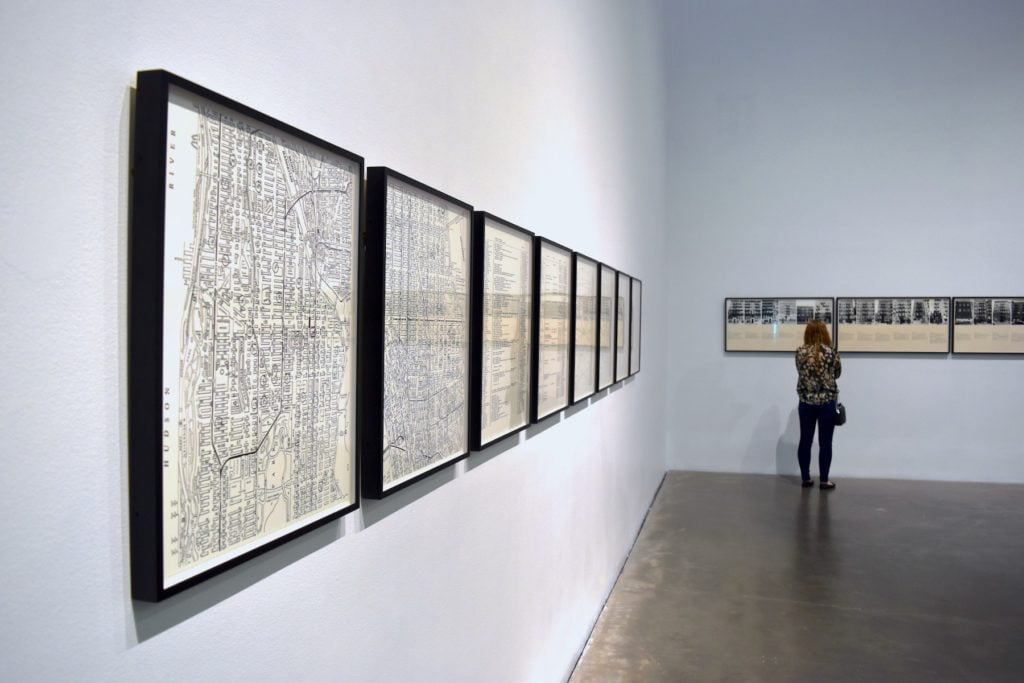
Hans Haacke, Shapolsky et al Manhattan Real Estate Holdings, A Real Time Social System as of May 1, 1971 (1971). Image: Ben Davis.
But here’s where it tips over into “Mandela Effect” territory: I vividly remember being taught that the reason that Shapolsky et al was censored was because Haacke had deliberately made a work about one of the museum’s own trustees. Indeed, this misreading is pervasive enough that the wall label, written by Haacke himself, rebuts it: “Many commentators assumed that the trustees of the Guggenheim Museum had links to the Shapolsky real estate group. There is no evidence to support such suspicions.”
Which means that what was, for me at least, the most famous work of “institutional critique” was actually not a work of institutional critique at all.
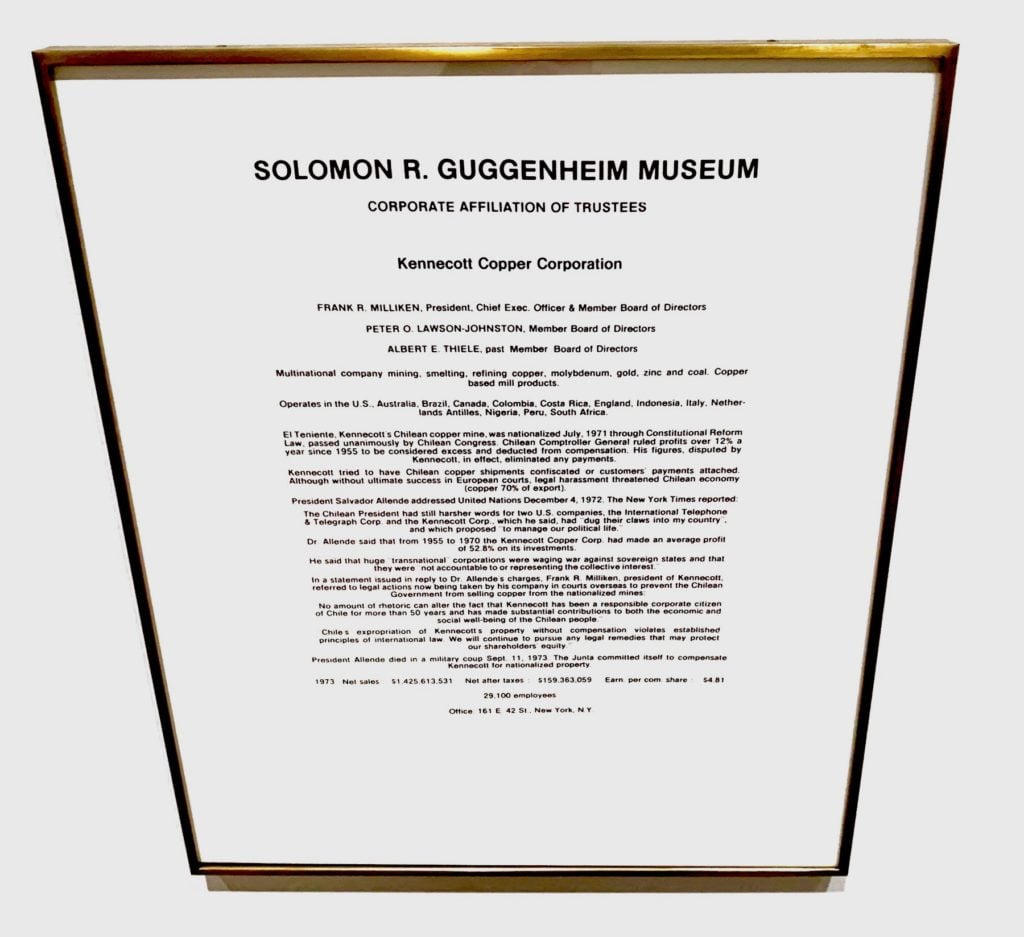
Panel from Hans Haacke, Solomon R. Guggenheim Museum Board of Trustees (1974). Image: Ben Davis.
Perhaps my teachers were conflating Shapolsky et al with another work, Solomon R. Guggenheim Museum Board of Trustees (1974), another presence in the New Museum show, one floor down. Hailing from a few years later, this laconic series of panels taxonomized the powerful men of that era’s Guggenheim board. It specifically pointed out their ties to the copper industry in Chile, where the US had backed the ultra-right-wing Pinochet dictatorship to overthrow socialist president Salvador Allende, deemed a threat to US interests.
Sometimes, critics have misremembered that Solomon R. Guggenheim Museum Board of Trustees was meant to be shown at the Guggenheim, which would have made it classic-type “institutional critique.” This, too, is false.
The work came out of Haacke’s reaction to the earlier museum censorship. But it was debuted at a commercial space, Stefanotty Gallery, in a show called “Live!” in early 1974, a few months after the September 1973 coup in Chile.
Despite the industry of writing on Haacke and the (to me) undeniable example he has set as a vigilant, astringent presence in art circles, this false art-historical memory makes me suddenly wonder if I have correctly comprehended what his example has meant at all.
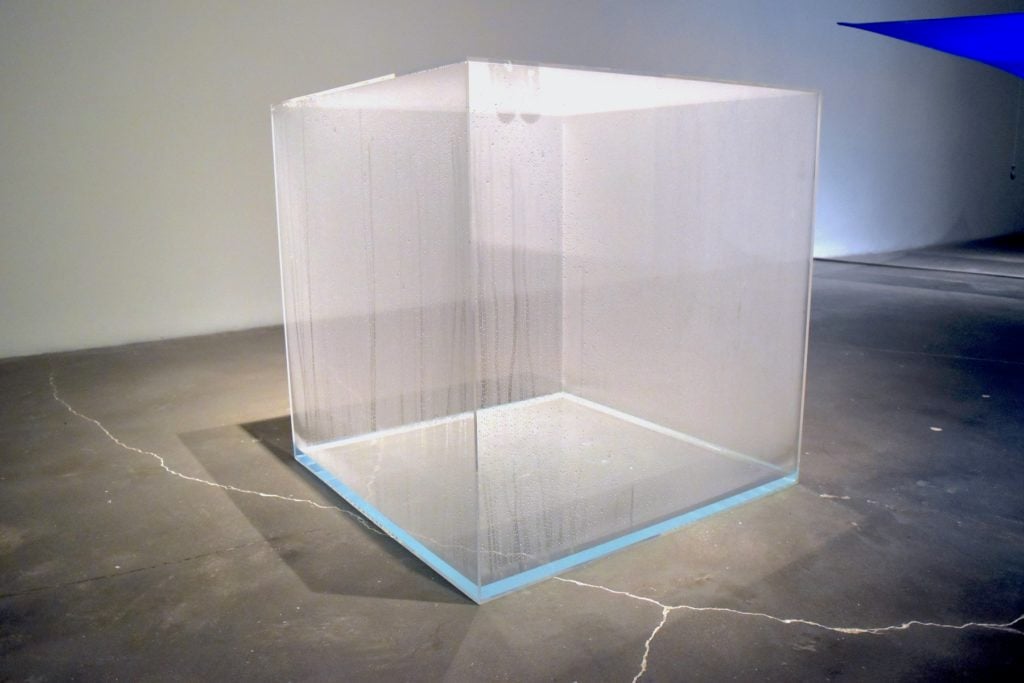
Hans Haacke, Condensation Cube (1963–65). Image: Ben Davis.
Head down to the second floor galleries of the New Museum show, which survey Haacke’s earliest 1960s works, to get a sense of the tenor of the progressive, experimental art scene of that decade.
Coming out of the technologically inspired arts of the Zero Group in Germany and the brainy industrial fetishism of New York Minimalism, these early Haacke works are all about insinuating dynamic systems into sculpture: most famously, with Condensation Cube (1963–65), a deadpan Plexiglas box that contains moisture and sweats on the inside based on the conditions of the galleries.
Other works introduce activity in different ways: Blue Sail (1964–65) or Wide White Flow (1967–2008) use air to animate planes of fabric; Ice Stick (1966) and Floating Ice Ring (1970) experiment with cooling elements to create evolving sculptural objects out of ice; Grass Grows (1967–69) is a large hill of dirt studded with living grass; Wave (1964–65) is a hanging Plexi container that you can move, activating the water within.
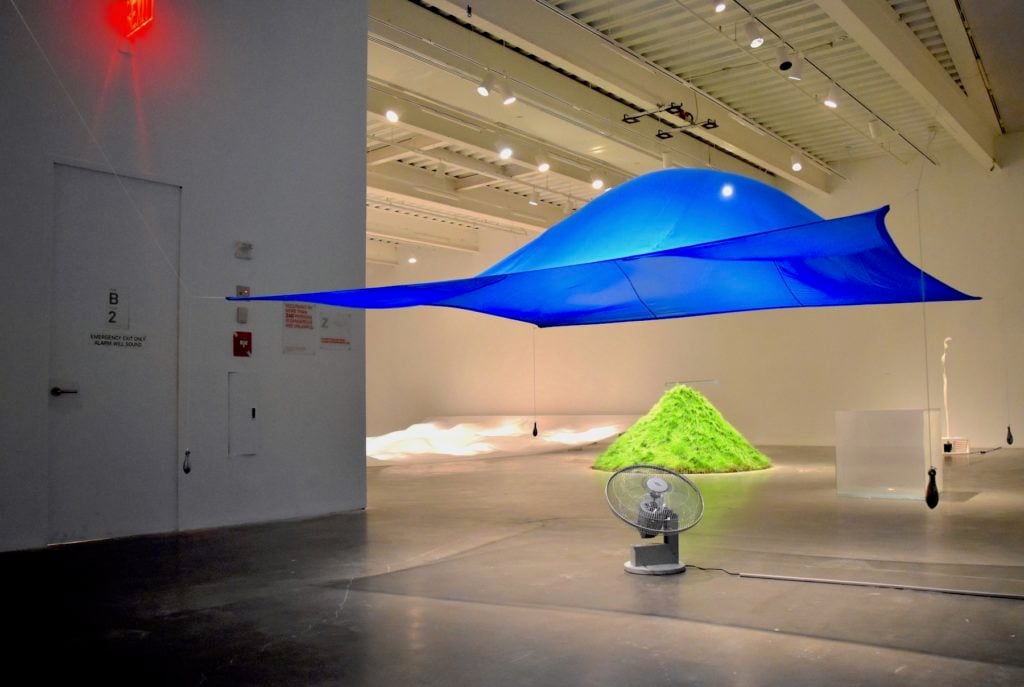
Hans Haacke, Blue Sail (1964–65). Image: Ben Davis.
These each look like science-project art, didactic exhibits displaced from the classroom and now teaching an unclear lesson. What was “radical” about them was how they invited participation and dynamic consciousness. Against the background of the priestly cult of contemplation of the reigning formalism, this felt like a vital, revivifying project at the time.
Haacke’s turn from exploring physical systems to social systems—and by extension, the webs of politics and economics around him—was influenced by his readings in the now-obscure, then-trendy field of systems theory. But more importantly, it was spurred by the cataclysmic events of the late ‘60s: specifically, the assassination of Martin Luther King, Jr. in 1968 and the nationwide urban revolts in black communities across the country that followed, sometimes known as the Holy Week Uprising or simply “the greatest wave of social unrest since the Civil War,” with scores of cities affected, dozens killed, and tens of thousands arrested.
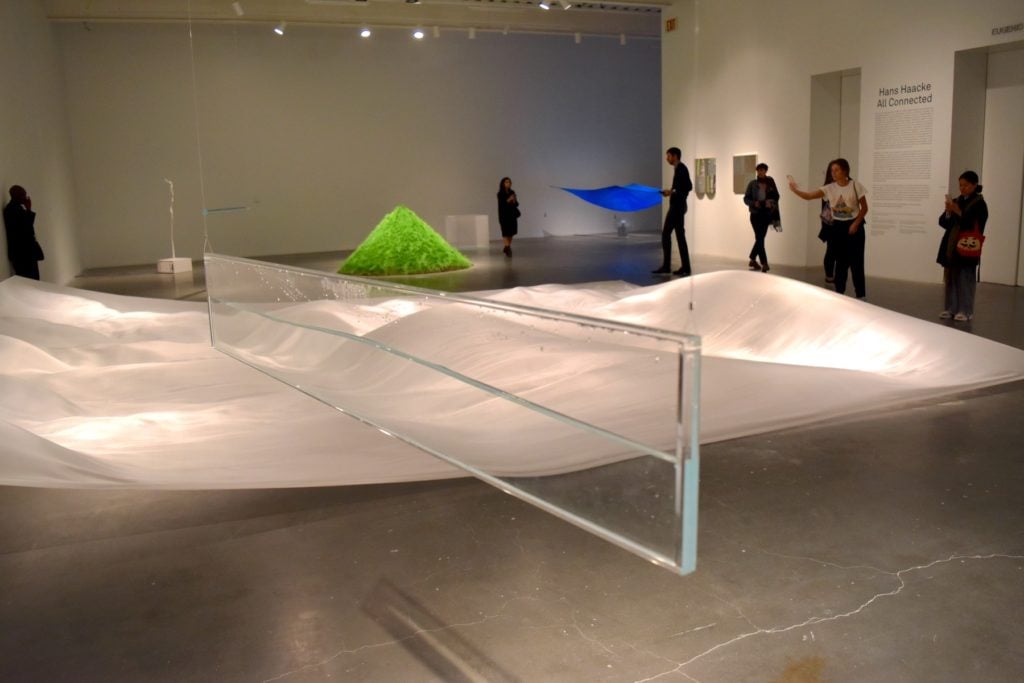
Hans Haacke, Wave (1964–65). Image: Ben Davis.
“No cop will be kept from shooting a black by all the light-environments in the world,” Haacke wrote to systems theorist Jack Burnham in a soul-searching private letter days after King’s assassination. Setting aside the antiquated vocabulary, the phrase makes clear how current events had forced the question of solidarity to the surface, and created a crisis of relevance for art.
Sometimes Haacke has been caricatured as caring only about some kind of disembodied economic critique, but Shapolsky et al was very specifically about slumlords. Its laborious taxonomy of economic interests is almost too on the nose as an illustration for the famous verdict of the Report of the National Advisory Commission on Civil Disorders (aka the Kerner Report), also released in ’68: “What white Americans have never fully understood—but what the Negro can never forget—is that white society is deeply implicated in the ghetto.”
![Hans Haacke, <em> Shapolsky et al Manhattan Real Estate Holdings, A Real Time Social System as of May 1, 1971</em> (1971) and [front] Hans Haacke, <em>Circulation</em> (1969). Image: Ben Davis.](https://news.artnet.com/app/news-upload/2019/10/haacke-circulation-1024x683.jpg)
Hans Haacke’s Shapolsky et al Manhattan Real Estate Holdings, A Real Time Social System as of May 1, 1971 (1971) in the background with Circulation (1969) on the floor in front. Image: Ben Davis.
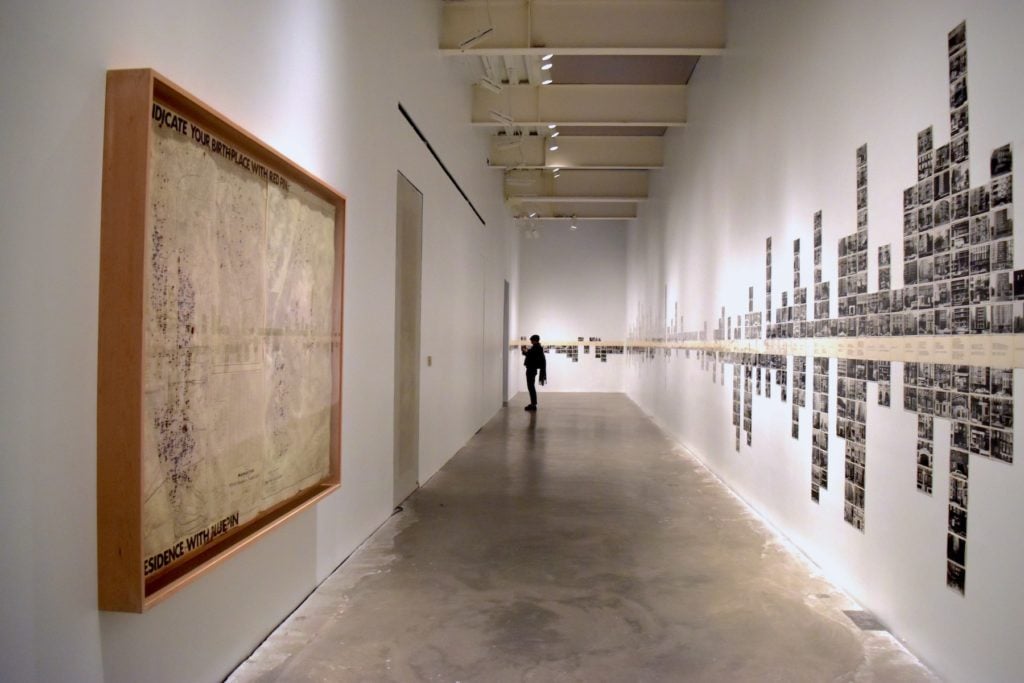
Hans Haacke, Gallery-Goers’ Birthplace and Residence Profile (1968–71). Image: Ben Davis.
The New Museum show includes a number of Haacke’s artwork-cum-survey projects from this time, which were shown in museums and commercial galleries. Gallery-Goers’ Birthplace and Residence Profile (1968–71) asked visitors to the Howard Wise Gallery to mark where they lived on a map. Haacke then photographed their homes and displayed the results, clustered by the specific streets where they lived, thus showing the audience’s confinement to certain, mainly elite enclaves.
The presentation of documentary evidence in Gallery-Goers’ Birthplace and Residence Profile unmistakably presages Shapolsky et al. Such gestures of art as citizen-journalism or citizen-sociology, you can easily see, express a new loss of faith in the universality of aesthetic experience. Haacke lays out just how narrow the gallery’s audience was. It was “an extremely select audience which recruits from the ranks of the college-educated middle and upper-middle classes,” he would write. “The professionally uncommitted public of the gallery can hardly be suspected of representing ‘the proletariat’ or the mythical ‘man in the street.'”
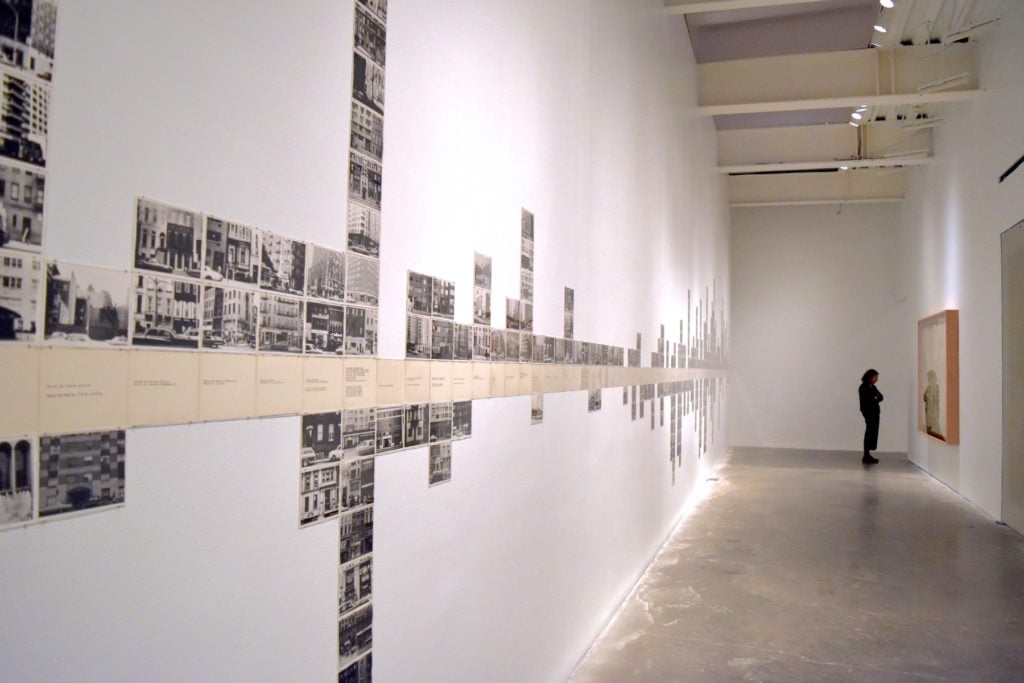
Hans Haacke, Gallery-Goers’ Birthplace and Residence Profile (1968–71). Image: Ben Davis.
The rudiments of what would later become “institutional critique” condensed around what Haacke called his “first really political work,” the MoMA-Poll of 1970. Activists in and around the Art Workers Coalition had been protesting MoMA for (among other issues) the institution’s connection to the Rockefeller family, with its ties to the war machine that was savaging Vietnam. Nelson Rockefeller was both on the board of trustees of the museum and governor of the state, making the coincidence of political and cultural power particularly glaring.
Joseph Kosuth, one of the progenitors of Conceptual art, once said that the movement’s de-mythification of high culture made it the “art of the Vietnam War era.” MoMA was eager both to mollify protestors and to maintain its status as the arbiter of the cutting edge, and so it organized an exhibition titled “Information,” which surveyed the experiments of recent artists with communications media. It is remembered as an important stop in the canonization of Conceptualism.
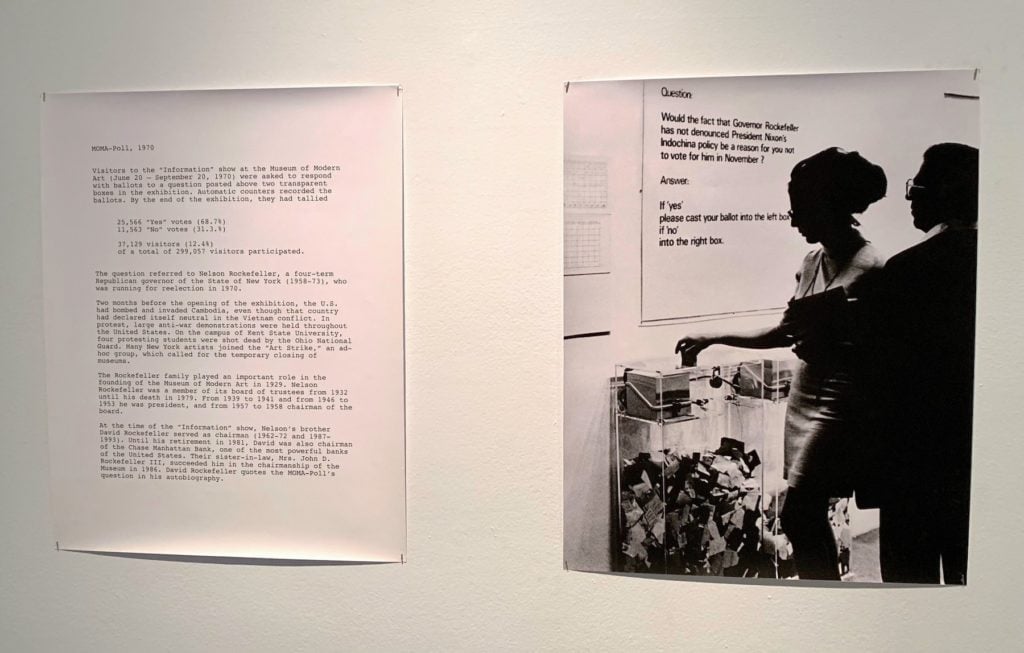
Images from Hans Haacke, MoMA-Poll. Image: Ben Davis.
It was in that context that Haacke presented MoMA-Poll, a clear box that asked museum visitors to vote on a question (“Would the fact that Governor Rockefeller has not denounced President Nixon’s Indochina policy be a reason for you not to vote for him in November?”) with color-coded ballots, displaying the results. This was something of a sneak attack: He hadn’t told the museum what issue the work was going to address before he installed it.
Some around the Art Workers Coalition objected to Haacke’s participation in the show as collaboration. His contribution did ruffle feathers inside, though. Museum director John Hightower recalled getting a call from Governor Rockefeller: “John, this thing is driving us nuts. You’ve got to get that out of there. You’ve got to kill that element of the exhibition.” Hightower talked Rockefeller down: “you think it’s bad now, if I pull that thing, having put the exhibition up and on public view already, it’ll just be a nightmare.” He thought Haacke “was trying to provoke a censorship issue.”
In the end, 25,566 people at MoMA’s “Information” show voted against Rockefeller, and 11,563 expressed support. (He went on to win handily in the November election.)
This behind-the-scenes scuffle presaged the open protests around the censorship of Shapolsky et al a year later (and it may explain why Shapolsky et al is misremembered as a work of “institutional critique”). The collision of energies in the moment is what impelled Haacke’s openly political, art-as-agitation approach as it came to set a new standard in the museum, testing the limits of what was permissible.
Yet there is a way to think of “institutional critique” as a retreat, rather than an advance.
Making political art in and about the museum was not, after all, the only model of engaged art-making available. Another model would be making art whose destination was outside the museum, and whose audience was not the art crowd, but social movements. At Martha Rosler’s recent Jewish Museum retrospective, I was delighted to learn that her most famous series of works, the collages called “Bringing the War Home,” produced in precisely the same period of anti-institutional art agitation of 1967–72, were not originally meant for gallery display. They were distributed as photocopies at anti-Vietnam War demonstrations and in underground newspapers.
This latter type of engagement requires, however, a robust milieu of sustained activist movements to be connected to. Unfortunately, Haacke’s evolution came at just the time when those movements were peaking. Shapolsky et al‘s title said it was “A Real Time Social System as of May 1, 1971″—which means the work literally coincided with the high water mark of the anti-war movement: the May Day Protests that shut down Washington, DC, with record arrests.
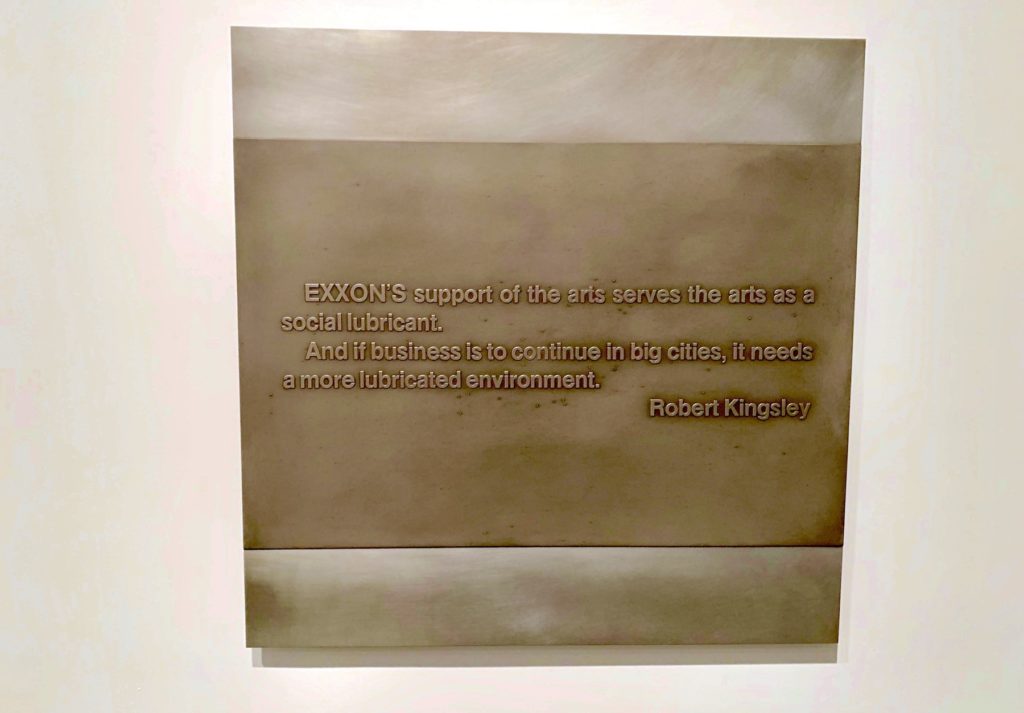
One panel from Hans Haacke’s On Social Grease (1975). Image: Ben Davis.
By the time Haacke made On Social Grease in 1975, for a solo show at the commercial John Weber Gallery, the reality that the ‘70s would be a long period of decline and retrenchment and splintering for progressive forces had begun to set in. That same year, Joseph Kosuth was lamenting in the journal The Fox that the radical experiments of Conceptual art had been “annexed” by the system. In an interview with October a decade later, Haacke would reflect that the Guggenheim censorship around Shapolsky et al already wouldn’t have received the solidarity it did if it had happened just a few years later, in ’75 instead of ’71:
I think I wouldn’t have received as much support. As soon as the Vietnam War was over and the draft abolished, everyone relaxed and thought, “Well, now we can go home, the fight is over.” People withdrew into their private worlds. This is the political vacuum which was then filled by the Right. We have to live with it today.
On Social Grease presented museum-style plaques ironically memorializing quotes from corporate types on the cynical reasoning behind company sponsorship of art. “Although not perceived at the time by the public,” Haacke explains in a New Museum wall label for the work, “corporate art collecting and sponsorship of art exhibitions by large corporations developed in the early 1970s at a scale and with an impact hitherto unknown.”
This is the interesting paradox of “institutional critique”: the very moment the museum was politicized by Haacke as a new kind of platform was also perceived as the moment when the museum was depoliticized and taken over as a new kind of platform for a corporate agenda.
Arriving at the same moment, these developments are two sides of the same coin. Populist demands for access to art meant that museums were now being framed as mass institutions in a new way, with new funding demands placed on them to create mass-appeal shows. Meanwhile, the era’s anti-establishment, anti-corporate sentiment sent companies looking for the humanizing PR that art sponsorship could provide. (Also in 1970, James Wines had coined the term “plop art” for the sudden trend of public sculptures popping up in public space, an effort to soften the public face of business and government.)
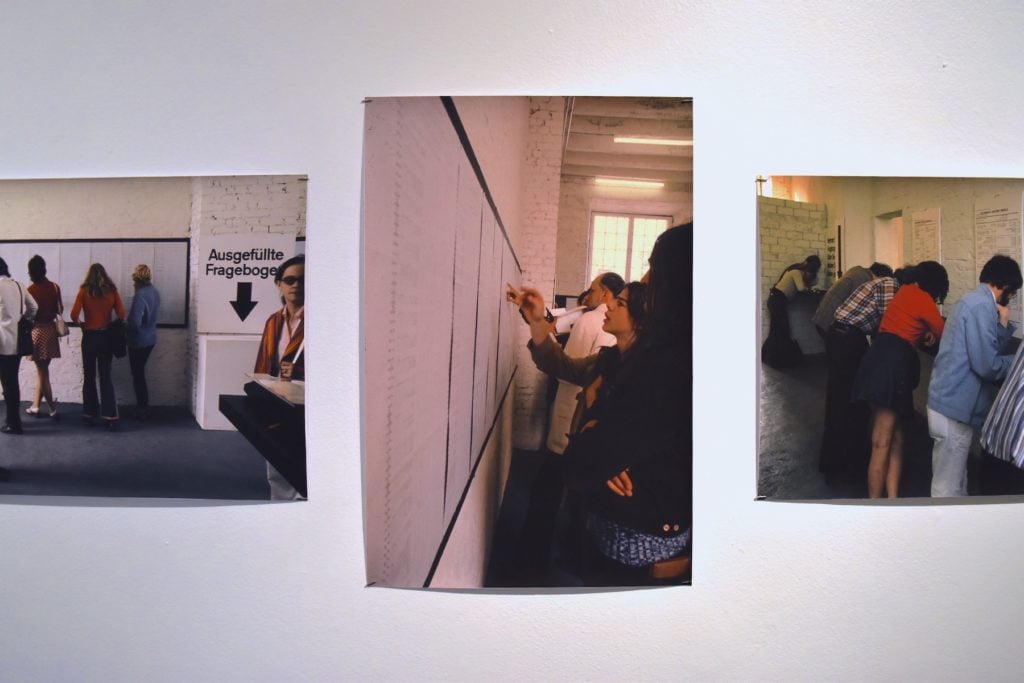
Photos from Hans Haacke’s documenta Poll. Image: Ben Davis.
As it coalesced into a genre, “institutional critique” would come to be seen as the critical form of artistic engagement by the 1980s, when Haacke got his first mid-career retrospective, “Unfinished Business,” also at the New Museum, with catalogue essays by big thinkers like Rosalyn Deutsche and Fredric Jameson. By 1988, historian Benjamin Buchloh declared Haacke the absolute exemplar of the radical artist in Art in America—even as progressive energies were routed in the streets, and a reconstructed and radicalized conservatism was triumphant in both economy and state. (Haacke’s MoMA-Poll is a reminder that the “Rockefeller Republicans” were never quite so progressive as advertised, but the name stands for a centrist posture swept away by the Reagan Revolution.)
That thumbnail sketch of contradictions fits a certain understanding of the fallout of the 1960s. Boltanski and Chiapello’s The New Spirit of Capitalism (and much other scholarship) identifies a rift between the “social critique” and the “aesthetic critique” in the era’s movements that became increasingly evident as time went on. The argument is that the powers-that-were came to embrace some demands for cultural change—but as a kind of bait-and-switch maneuver, simultaneously rolling back or suppressing demands for deeper system change.
Thus, the elite spaces of culture and the academy became more open to a rhetorical (and sometimes actual) radicalism, even as the economy and politics became more cutthroat and extremist. That was the social compromise.
Haacke’s own surveys of artgoers had shown how eccentric and isolated the art context actually was. Without connections to wider social, political, and economic change, it could only remain stranded. The obsession with art’s internal politics in “institutional critique” may be better understood as a soul-searching admission of that isolation than as the ideal template for what art can be.
Where this actually took Haacke’s art in the 1980s and beyond, however, is a thought-provoking enough topic for its own essay.